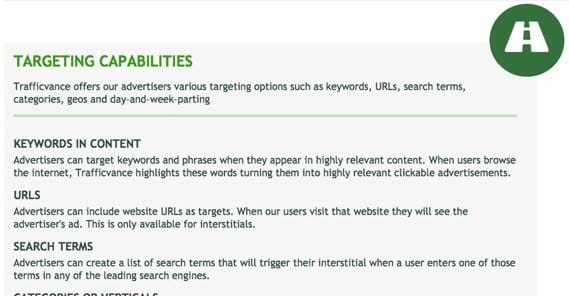Trafficvance Review on Revenue and Performance

What is Trafficvance? In a nutshell, it’s an advertising network for affiliate marketing. Advertisers put offers on the network, the network shares them with a wide audience of publishers, and the publishers run the ads on their sites. The service has existed since 2006, and it has a reputation as one of the most profitable such networks available online today. In fact, for a long time they were so exclusive that they required a referral from an existing user in order to even register as a publisher.
Trafficvance boasts highly targeted traffic using a range of different ad placements, including banners, pop-ups, text links and contextual advertising. They’re also available in a number of different countries, ranging from the USA and Brazil to Australia, India and most of Europe. They avoid some of the worst clickfarm countries, too, so you don’t have to worry about geo-blocking them out.
The Audience
First, let’s take a look at the statistics Trafficvance publishes about their audience.
- Their primary audience is actually married females with children, making purchase decisions online most days. Their secondary audience is urban males with a lot of social activity shopping online for convenience.
- Their primary focus is on US app and game advertising, with over 350 million impressions per month, all targeted.
- Their primary age range is from 35-44 years old, with the 18-24 demographic taking second place. Household income is primarily in the 40K to 60K range.
- They boast growth of 25 or more every quarter for the past three years.
The Targeting
Trafficvance, as mentioned, has some robust geo-targeting for the areas they’re active in. They also have targeting by content keywords, which is par for the course and is the primary source of targeting for most publishers. They can target by URL for interstitial ads if they so desire. Search terms and verticals are also available, through pre-built lists.
Honestly, I’ve found that the Trafficvance categories are a little restrictive. There are a lot of them available, but they aren’t necessarily as granular as you might want. This means you might end up bidding against people you otherwise might never encounter, because of the too-similar category niches.
The Analytics
Trafficvance has customizable JavaScript and Pixel tracking for conversion tracking, which is highly useful. They also allow DART, Omniture and Google Analytics, among others. Their conversion reporting tool is great, and their general reporting is fairly accurate. I wouldn’t mark their analytics as intrusive or inaccurate, myself.
If you like, Trafficvance publishes case studies for some of their more successful advertisers. This gives you an idea of the quality, volume and cost of the traffic you would get as an advertiser, but it doesn’t give you a lot to go on as a publisher. Obviously, they’re going to cherry-pick success stories, but who wouldn’t? Take them with a grain of salt, of course.
Their Ads
One interesting thing about Trafficvance is that they’ve kept up with the times. If you look at reviews or old information from several years ago, you see people giving you a rundown of their ad types and including Flash banner ads, adware, pop-unders and billboard-style ads. Meanwhile, if you look at Traffivance today, you see that they only talk about using contextual text links and interstitial advertising.
This is a testament to how adaptable and how concerned Trafficvance is about quality for their advertisers. When an advertising technique becomes black hat or stops working very effectively, they don’t ignore the way the wind blows. Instead, they disable or drop the technique, forcing publishers to adapt to the times. This can be a bit annoying for the low-effort publishers out there, unfortunately. For advertisers, however, it guarantees that the advertising used is going to be high quality.
Their Performance
Overall, I’m quite impressed with Trafficvance. They’re consistently one of the top advertisers, within their niche. This is important! They’re not the most generalized network out there, which is both good and bad. It’s good, in that it means if you’re in their niche you always have something to bid on. It’s bad, in that if you’re outside their niche or demographic, you don’t have a lot to do.
Their ads are generally contextual, using their own algorithms, which are accurate for an affiliate network. I’m used to some very basic keyword targeting with little variation or sensitivity, but Trafficvance is excellent by comparison. They aren’t the most robust out of every network I’ve used, but they’re still quite good.
The game and app-centric niche is wonderful for anyone really getting into mobile-specific marketing. Conversely, if you don’t know how to cater to mobile users, you’re going to be working at a significant disadvantage compared to other users of the site.
Tips to Perform Well
First of all, one of the biggest mistakes I see people making with Trafficvance is trying desperately to reach position #1 on the bidding as an advertiser. Sure, position #1 has some benefit, but it’s often quite a bit more expensive than even position #2. If you can shoot for the second spot, you’ll get almost as much traffic for a significantly lower price.
Second, stick to the text links. I’ve seen the interstitials used, but they’re not really as effective because they’re more intrusive and tend to interrupt the user experience. This is generally bad practice for advertisers and publishers of all stripes. You want the best user experience possible.
Third, of course, make sure your links stand out. I know the trend a few years ago was to make the links blend in enough that they’re hard to identify, but that’s just a bad idea. Google can count it as cloaking, and besides, if you’re hiding your links, who can click them? Make them prominent and visible. Native is a good idea, but remember that native just means “meshing with the rest of your site” not “hidden from view in shame.”
 ContentPowered.com
ContentPowered.com








